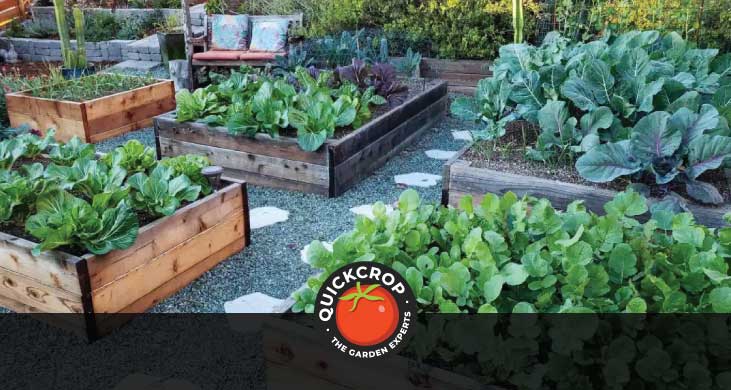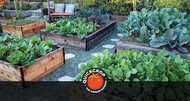High Yield Vegetables

A high yield vegetable is one that produces a large amount of end product per area of planting. ‘Output’ shouldn’t be seen as the be all and end all of growing your own food, but high yield vegetable gardening can help you make the most of limited growing space. This is especially true when combined with methods like vertical planting or succession planting. Some vegetable crops are renowned as being productive and super-efficient growers: indeed, they may end up presenting you with a bigger harvest than you know what to do with!
- High yield crops can be a great way of getting some wins ‘under your belt’ as a beginner gardener. An abundant harvest can be a real confidence-booster
- Offering some of your excess produce is a great way of ingratiating yourself to your neighbours.
- Having lots of homegrown vegetables on hand is a great motivation to eat healthier.
- It can also encourage you to try out new preparation techniques for a familiar vegetable, whether it’s cooking it differently or using it as an ingredient in a recipe.
Tomatoes
Given the right growing conditions, the tomato is a prolific crop. If high yields are the goal, then consider cherry tomatoes in particular: the plant may be compact but it can produce hundreds of sweet-tasting fruits. An example is the tellingly-named ‘Supersweet 100’ variety. Cherry varieties are easy to grow and will need less growing time, which can be a bonus when the growing season is shorter.
In our cooler climate tomatoes will do better when grown under cover, but you don’t necessarily need a polytunnel or greenhouse if you don’t have the space or funds: cloches, frames or growhouses can be used (and are often designed especially for tomatoes).
View Supersweet 100 F1 Cherry Tomato
Courgettes
The ridiculously large harvest you can get from just a couple of courgette plants is something of a running joke in gardening circles. You may well find yourself trying to offload them to your friends or neighbours! And they’ll likely be thanking you, as home-grown courgettes are fresher and more flavourful compared to their store-bought counterparts.
Sow your courgette seeds in small pots with fine seed compost. Gently water and leave indoors on a warm windowsill, or in a propagator if you want to get them going quickly. Courgettes are not frost-hardy, so plant them out in June when the risk of frosts has passed. If growing in an unheated greenhouse or polytunnel, be sure to cover them with fleece at night to protect them from potential frost damage. If you've raised them indoors, they'll need to get used to outdoor temperatures and conditions before planting out: a cloche is a good way of easing the transition.
For best flavour, pick them when they're small. They are versatile in the kitchen - hopefully the variety of preparing options will make it easier to get through your bounty! How about using them to make some tasty chutney?
Runner Beans
Runner beans are a productive crop for a few reasons: most varieties are climbing plants, which means you can use tall canes, supports or wigwams to maximise your growing space. They produce a formidable amount of pods per plant, they have a long growing season and will keep producing as you harvest the beans. One variety we particularly recommend is the early-cropping ‘Enorma’.
Improving the soil with organic matter or manure at least 2 weeks in advance of planting is good practice. Providing some shelter will protect them from strong winds. Runner beans need plenty of moisture, so regular irrigation is important in dry conditions. Early sowing is risky, as the seed needs a minimum temperature of 10°C to germinate (The lightest touch of frost can kill them). It’s best to pick them when they’re young: if they’re left too long they can become tough and stringy. Once you start harvesting beans, you can keep picking right through until early Autumn. Harvesting the plant consistently means that it can divert its energy back to producing beans afresh.
Asian Salads
Asian salads or Asian greens refers to a range of leafy vegetables commonly sold in Asian supermarkets that have become more and more popular with westerners who like to grow their own food. Generally these salads are a good bet when it comes to yield, but it's always nice and illustrative to point to a particular example - in this case 'Mizuna'.
Mizuna is a Japanese leafy green with a pleasant peppery taste. It grows vigorously, is cold-tolerant and is pretty prolific once it gets going, with a long growing season. Like many Asian salads, it will even do well grown in Autumn.
Mizuna is closely related to brassicas like broccoli or kale: it’s a very nutritious crop and a great source of antioxidants. A popular ingredient in salads, soups or risottos, it can be eaten raw or cooked. Enough of that though, what about growing tips? Seeds can be sown outdoors from March to early Autumn. Mizuna is adaptable, but will thrive in fertile free-draining soil. In very hot or dry conditions, there is a risk of bolting - this risk can be lessened with early sowings. Young seedlings will need to be protected from slugs, but generally this is a fairly low-maintenance crop.
It’s pretty fast-growing and can be harvested within three weeks of sowing. You can use the cut-and-come-again approach, picking the outer leaves while the plant keeps producing. Eat right after harvesting to get the best flavour and nutritional value.
Perpetual Spinach
Despite its name, Perpetual spinach is actually a part of the beet family (it’s also known as swiss chard or chard). If you harvest the leaves as they grow it will continue producing leaves for most of the year, so it’s a great crop for those with a small growing space. It’s also a good crop for the cooler months: in fact, the leaves are at their tastiest in cooler weather and there will be less risk of bolting.
Perpetual spinach can be harvested as baby leaves and eaten raw, with an earthy, slightly bitter taste. Larger leaves can be boiled or steamed, while the colourful stems are edible too - they can be sliced and sauteed, and are often used as a substitute for asparagus.
Hardy and fast-growing, The crop will do well in a soil with good drainage and a high organic content - it won’t appreciate an acidic soil though.
Sugar Snap Peas (and Peas in general!)
Peas are a good choice for home growing, because they will always taste so much better when freshly harvested as opposed to shop-bought. One of the more productive types are sugar snap peas. They do well in cooler temperatures, and can be planted as early as February - but it’s probably best to wait until early spring to reduce the risk of frost damage.
Sugar snap peas are best grown in a sunny area, although they can tolerate partial shade. They can be planted in the soil or in pots, containers and small raised beds. Wherever you choose to sow, make sure to provide some climbing support in the form of a trellis, cane or pole. The peas will need protection from mice and slugs. Some fine mesh may help, while other creative gardener solutions include using an empty plastic bottle as a covering or sprinkling them with chilli powder.
They can be eaten raw from the pod (which itself is also edible) and are a great healthy snacking option for kids. They will lose their sweetness as their sugars turn to starch, so eat them soon after harvest if possible.
Lettuce
Several lettuce varieties are hardy enough to be grown in the cooler months, so if space is an issue you can set them aside in your garden planner while your main-season crops grow. Loose leaf varieties of lettuce can be harvested via the cut and come again method, picking the outermost leaves (a few at a time) and allowing it to keep producing further harvests. With cut and come again you can start picking leaves after 7-8 weeks. Loose leaf lettuces are a good option for small growing spaces or containers.
Other lettuce types such as ‘cos’ (Romaine) or crisphead are no slouches either in the productivity department. These are grown as full plant heads and will have denser growth. Lettuce is a pretty low-maintenance crop to grow, and with a long growing season you can keep harvesting leaves for much of the year.
Modular trays are especially good for sowing lettuce as they protect the emerging seedlings from slugs. Many lettuce varieties will struggle to germinate when the temperature of compost is above 25°C, so placing them in a cool spot for a couple of days is a good idea before bringing them back to the polytunnel. Garden fleece or cloches will protect early (or late) sowings from frost.
Cucumber
Cucumbers can do well growing outside in a warm sheltered area of your garden, but for a truly prolific harvest (and the tastiest cucumbers) it’s best to grow them in the polytunnel or greenhouse. A single plant can produce over 40 cucumbers. When home-grown they are far superior to the store-bought kind, as they can be picked at just the right time for a perfectly ripe and juicy taste.
Bush cucumbers may be more suitable for small-space gardeners, lending themselves well to container-growing. Vining cucumbers, on the other hand, will produce a more abundant crop - and as the name suggests you can make use of vertical supports, trellises etc to allow them to grow tall. 'Passandra F1' is one of our most recommended varieties, producing massive yields of juicy, medium sized fruits.
A large harvest of cucumbers can be used up in a variety of ways without feeling like you have to start giving them away: there are almost countless ways you can pickle them, for example. Cucumber seeds will need 20˚C to germinate; they will then need to be kept warm until they are ready to plant in the polytunnel in mid to late May.
Potatoes
Potatoes are reliable growers with a very satisfying yield. It’s natural to think that they’ll need a lot of space, but they’re very adaptable and can be grown in containers or even planter bags if you’re tight on garden space. You can also choose what variety to grow, whether it’s earlies (harvested in late June or July) or maincrop (harvested from October onwards). Earlies are recommended for the beginner because they take up less space and will be ready to harvest sooner (usually 10 weeks after planting). This means that you can put in another crop once they are harvested and make more extensive use of your garden space. Earlies are also less susceptible to the dreaded blight. Another factor that can increase your potato yield is using a rich compost like Envirogrind.
